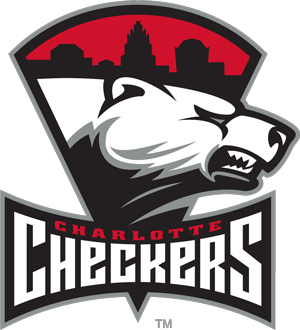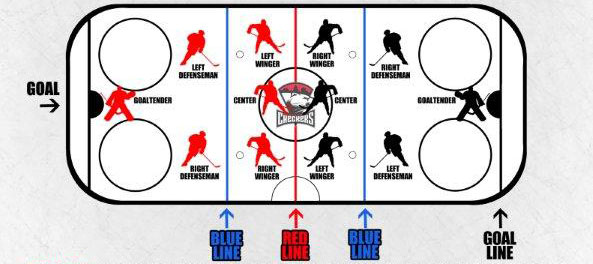The Game
A Hockey Game: Consists of three 20-minute periods with two 18-minute intermissions.Players: Each team has six players on the ice at any given time (except when a penalty occurs): center, right wing, left wing, two defensemen and a goalie. Each team can dress a maximum of 18 skaters and 2 goalies (20 total).
The Puck: Is a six-ounce piece of vulcanized rubber. It is three inches in diameter and one inch thick and is frozen before games to minimize bouncing.
The Rink: 200 feet long and 85 feet wide.
The Goal: Is four-feet high by six-feet wide. Goals are worth one point each and are scored when the puck crosses the goal line and goes into the net. Offside: No player may precede the puck into the offensive zone. I.e.: When Player 1 (see diagram above) has the puck in what is called the neutral zone and Player 2 crosses the blue line before the puck is in the offensive zone, he is considered offside. *In a delayed offside situation, the offending player(s) will be permitted to negate the offside by "tagging up" at the blue line by returning to the blue line to touch and clear the zone.
Icing: When Player 3 (see diagram above) plays the puck from behind the center line to a point beyond the opponent's goal line (into the offensive zone). Icing is not called when the team is playing short-handed. A team that is guilty of an icing violation will be prohibited from making a line change prior to the ensuing faceoff.
Hockey Positions
The Six Men and What They Do
Each team plays six men at one time (unless someone has been put in the penalty box) and an active roster can include as many as 20 players. Substitutions are made while play is in progress. The positions are goaltender, left/right defense, center, and left/right wings.Goaltender: The goalie's responsibility is to keep the opposition from putting the puck into his goal. Offensively, he can start his team down the ice with a pass, but he seldom leaves the net for other reasons.
Defensemen: Defensemen try to stop the incoming play, block shots, cover opposing forwards and clear the puck from in front of their own goal. On offense they get the puck to the center and wings and follow the play into the attacking zone to maintain the offensive momentum.
Center: The center takes faceoffs and leads the attack by carrying the puck on offense. He exchanges passes with the wings to steer the play toward the enemy goal. On defense he tries to break up a play before it gets on his teams side of the ice and continues to harass their play in the neutral and defensive zone.
Wings: Moving up and down the sides of the ice with the direction of the play, the wings work with the center on the attack to set up shots at the goal. Defensively, they try to disrupt plays by the opposing wings and block their shots.
Hockey does not employ a variety of set plays like football does. Instead, the players must react instantaneously to a variety of situations.



